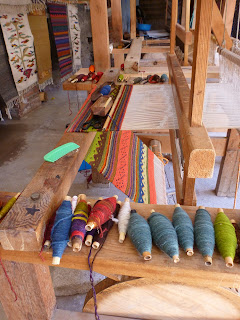While it isn't very high, its stem is massive, and a sign says it is more than 2000 years old and weighs some 600.000 tons. Standing under its canopy, the view up at the leaves and branches is quite impressive:
The second stop was a small village, Teotitlán del Valle, that is famous for its weavings. They did a short demonstration of the production of wool, its coloring, and the weaving itself - all done manually - but the main purpose seemed to be to get people to buy stuff. The division of labor in this village seemed to be that women make and color the wool, and the men are in charge of weaving. These are some of the looms that have unfinished goods on them:
The next stop was another sales event - but this time I was actually interested in the explanations they were giving before the sales part because they concerned the production process of Mezcal. Like Tequila, Mezcal is made out of a certain type of agave, the maguey. Tequila is made out of the blue agave, and it received its name because it was first produced in a town called Tequila. Since the blue agave doesn't grow in the Oaxaca region, the liquor here is made out of the maguey agave and called Mezcal, but the production process is exactly the same.
Basically, you cut off the leaves of the maguey, cook the trunk, cut it in pieces, grind it a bit, let it ferment, and distill it. Sounds simple enough, doesn't it? ;-) This process being finished, you arrive at white Mezcal. Just like with other liquors, you can then decide to let it sit in a wooden barrel for a couple of years to improve its taste. And then there's something you can do that's kind of special to Mezcal: you can add the Maguey worm to have the Mezcal take on some of its taste. This is what the worm looks like:
Presented with the opportunity, I had to taste the worm, of course. It has an interesting taste, not bad at all, and apparently it is regarded as a delicacy in Mexico. It is not only used in the making of Mezcal, but also in a variety of dishes and sauces.
After the explanations were over, we were invited to taste as many varieties of Mezcal as we wanted. There were three varieties of pure Mezcal with about 40% alcohol: a white one, an 8 year old one, and one with the maguey worm. In addition, there were at least 15 varieties of Mezcal cream, containing something like 15-20% alcohol. The creams were Mezcal-based drinks with some kind of flavor added, for example mocha, pineapple, boiled milk, maracuya, cappucchino, Oaxacan herbs, etc.
All of the variants tasted quite nice; the aged ones were much smoother than the white one, and the creams were nice and sweet. Still, Mezcal wasn't my instant favorite. I felt it didn't taste very strongly at all, rather like wodka or rum - and most certainly nothing like whisky.
The last stop for the day were the ruins of Mitla. After the decline of Monte Albán, Mitla was one of the villages that profited and became more powerful. This also means that the ruins are somewhat newer, dating from some time after 1000 DC. The building on the following picture is the one that is preserved best:
What happened to the other buildings in the complex is that the Spanish, once again up to no good, dismantled the buildings and reused the stones to build the nearby church. Originally, the base of the decorations on the buildings, as well as the walls and floors, were painted red with a color made from iron oxide. At one of the interior passageways, the there was still some of the painting left:
Just imagine how grand the buildings and squares must have looked, all painted bright red, and the decorations standing out in white.
Based on the decoration at the bottom of this picture, the guide tried to sell us the idea that Mesoamerican civilizations had been the first to invent the decimal system (there are ten stripes in each of the batches in the decoration). That was the point at which I decided to stop listening to his rambles, explore on my own and read up the facts on the internet later. Sure, Mesoamericans may well have been one of the civilizations to use the decimal system, but they surely weren't the first ones to do so - that might have been the Egyptians, around 3000 BC.








